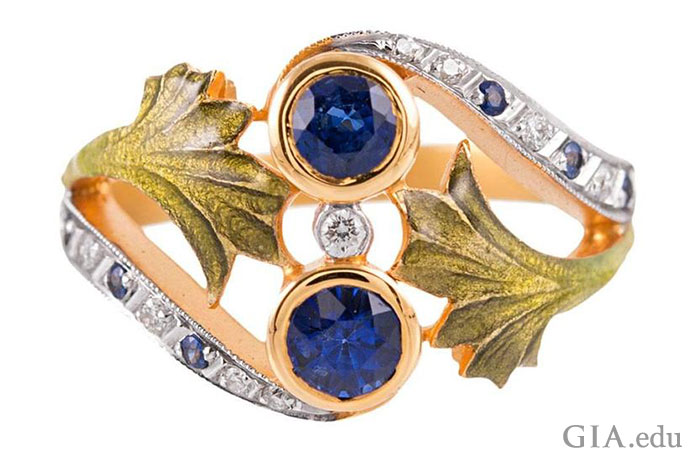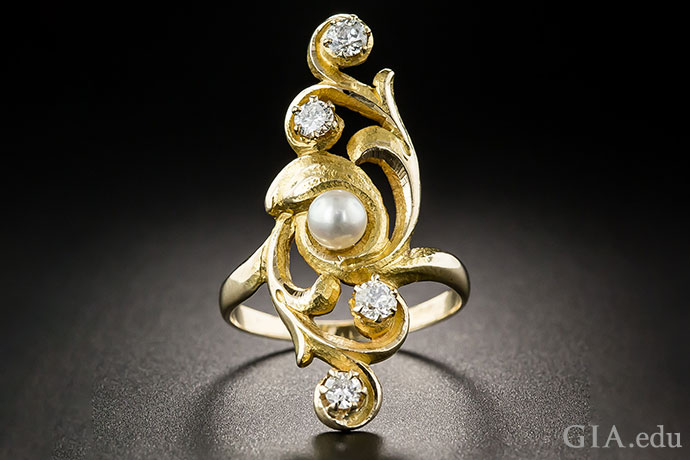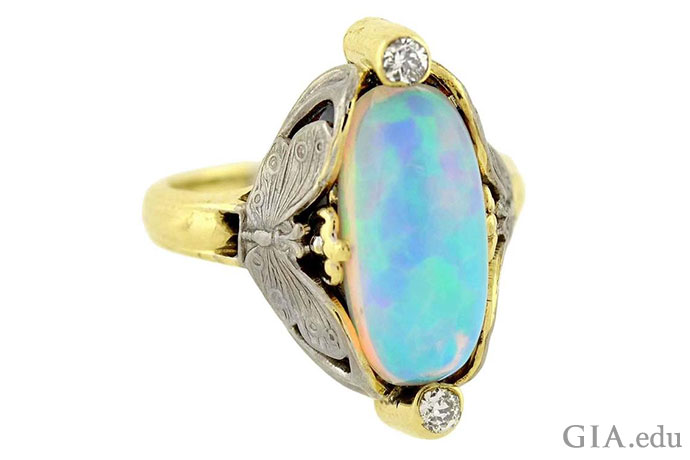Art Nouveau engagement rings epitomize exquisite beauty and rarity, embodying a bygone era of unparalleled romance and artistic innovation. While authentic pieces from this period are scarce treasures, one can infuse the essence of Art Nouveau into their own bespoke ring design, evoking its ethereal charm through carefully curated design elements such as the sinuous whiplash line, vibrant enamel, and lustrous colored gems.
During the Art Nouveau movement, which blossomed in the late 19th century and flourished into the early 20th century, visionary jewelry artisans drew inspiration from a rich tapestry of influences. Enamored by the organic forms of the natural world and driven by a fervent desire to transcend the constraints of Victorian design orthodoxy, they embarked on a creative odyssey unlike any other. The renewed cultural exchange with Japan, following centuries of seclusion, ignited a renaissance of artistic exploration, with Japanese aesthetics influencing the avant-garde sensibilities of the era. Drawing from Japanese artistry, characterized by asymmetry and a minimalist ethos, Art Nouveau designers forged a symbiotic relationship between nature and art, birthing a movement of unparalleled innovation and splendor.

Exuding the timeless allure of Art Nouveau, this contemporary ring serves as a captivating ode to the bygone era of artistic ingenuity and opulence. Infused with the signature motifs of the movement, it presents a veritable symphony of design elements awaiting to be woven into the fabric of a bespoke engagement ring. Delicately enameled leaves cascade around the twin sapphires, their azure brilliance totaling an impressive 0.80 carats, while a trail of sapphire and diamond melee adorns the band, casting a mesmerizing sparkle at every turn. A masterful creation that seamlessly blends the elegance of yesteryear with the sophistication of modern craftsmanship, epitomizing the enduring legacy of Art Nouveau in contemporary jewelry design.
Art Nouveau Style: The Whiplash Line
In the illustrious tapestry of Art Nouveau, the sinuous and asymmetrical whiplash line emerges as a hallmark motif, embodying a harmonious union of movement, grace, and power. Evoking the fluidity of a cracking whip, this distinctive line infuses designs with a sense of dynamic energy and ethereal beauty. By incorporating intertwining lines into ring compositions, one can evoke the profound symbolism of two lives intertwined, thus imbuing Art Nouveau-inspired engagement rings with an unmistakably authentic period allure.

René Lalique stands as a luminary among the great artisans of the Art Nouveau epoch. His masterful creation, adorned with the quintessential motifs of the era, serves as a testament to his unparalleled vision and craftsmanship. Behold the sinuous whiplash lines, delicately entwined amidst the ethereal allure of two majestic peacocks, rendered with exquisite detail. Cloisonné enameling, an ancient technique revitalized with modern elegance, graces this piece, while opulent opals and luminous pearls evoke a sense of otherworldly enchantment. A masterpiece of artistry and innovation, this creation epitomizes the essence of Art Nouveau splendor. Courtesy: The Metropolitan Museum of Art, New York. Gift of Clare Le Corbeiller, 1991.
Art Nouveau Style: The Use of Enamel
Enameling emerged as a cornerstone technique in crafting the enchanting, fantastical allure of Art Nouveau jewelry, infusing each piece with an ethereal, dreamlike quality. With roots tracing back to 1400 BCE, enameling involves the meticulous fusion of glass onto a metal substrate, resulting in a luminous, colorful finish that captivates the senses. Art Nouveau artisans embraced a myriad of enameling techniques, each contributing to the mesmerizing complexity of their creations:

Modern bracelet flaunts Art Nouveau charm with purple basse-taille enamel and gold cherries.
Photo: Eric Welch/GIA. Courtesy: Mark Maxwell
Cloisonné entails the meticulous creation of miniature cells, or cloisons, using delicate wire on a metal backdrop. Each cell is meticulously filled with powdered enamel of a chosen hue before undergoing the firing process.
Champlevé involves the intricate excavation of cells or lines into metal, where powdered enamel is carefully placed into these recesses before being fired to achieve a vibrant finish.
Basse-taille, translating to “low cut” in French, entails the intricate engraving or carving of metal to varying depths of low relief. Transparent enamel is then applied, allowing light to play upon the colors in captivating tones post-firing.
Plique-à-jour emulates the radiant beauty of stained glass, with enamel powder delicately added to a cell backed by a thin sheet of copper foil or similar metal. Upon firing, the backing is gently removed, leaving the enamel unbacked and transparent, akin to a luminous pane of glass.
While enamel lends an exquisite touch to Art Nouveau engagement rings, its delicate nature requires judicious use and careful protection within the mounting, ideally nestled within recessed areas. When maintaining such rings, a gentle clean with a damp cloth is recommended to preserve the integrity of the enamel work.

In this ring by René Lalique, circa 1900, two enameled poppies soothe the eye. The baroque freshwater pearl nestled between them is a delicate complement. Courtesy: 1stdibs.com
Art Nouveau Style: Celebrating Nature
Art Nouveau artisans found inspiration in nature’s wonders. From majestic peacocks to delicate butterflies, wildlife motifs graced their creations, evoking a sense of fantasy and allure. Transform your engagement ring with these enchanting designs.

Pink, blue and lavender morning glories are featured in this gold and plique-à-jour enameled corsage ornament, circa 1900. Nature is beautifully depicted in this symbolic piece. Photo: Judy Colbert/GIA

This gold Art Nouveau ring, circa 1900, is set with an old mine cut diamond that weighs 0.48 carat (ct). Curving, intertwined lines create a design that resembles vines or branches. Courtesy: Doyle & Doyle.

Like comets with long tails, the two main diamonds (a total of 0.36 carats) in this Art Nouveau style ring are trailed by curving diamond-studded lines that swirl throughout the ring. Courtesy: 1stdibs.com
Art Nouveau Style: Pearls
Given the Art Nouveau era’s reverence for natural beauty, it’s no wonder that designers were captivated by pearls. These treasures from the depths of Earth’s waters adorned pendants, brooches, and even engagement rings of the period. However, pearls, with their delicate nature and low hardness on the Mohs scale, demand gentle handling. While not ideal for everyday wear in a modern engagement ring, they exude elegance in Art Nouveau-style pendants or earrings, complementing your bridal ensemble with timeless allure.

The pearl in this vintage Art Nouveau cocktail ring is like the calm eye of a storm, with a hurricane of curved lines swirling around it. Four diamonds shine like stars in the night sky. Courtesy: LangAntiques.com
Art Nouveau Style: Unusual Colored Gemstones
Art Nouveau jewelry, gemstones played a vital role in crafting pieces that mirrored the sublime beauty of nature. Among the cherished materials were those reminiscent of celestial wonders and aquatic depths, such as moonstone, lapis lazuli, and opal. Yet, a word of caution before adorning your Art Nouveau-inspired engagement ring with these enchanting gems: while breathtaking, they may not withstand the rigors of everyday wear.
Moonstone, a favorite among Art Nouveau artisans, casts an ethereal glow akin to moonlight dancing on water. Known for its captivating adularescence, this gem, a variety of orthoclase feldspar, boasts a spectrum of hues from serene whites to vibrant blues and greens. However, with a hardness rating of 6.0 to 6.5 on the Mohs scale, moonstone demands gentle handling to avoid chipping or scratching, making it a choice best suited for special occasions rather than daily adornment.

This vintage Art Nouveau-style ring conjures a celestial scene: A pale moonstone is orbited by eight diamonds. Courtesy: LangAntiques.com

A moonstone is the centerpiece in this modern ring, which was inspired by the Art Nouveau era. Courtesy: MetamorphosisJewelry.com
Lapis lazuli, a beloved gem of Art Nouveau artisans, captivated with its rich hues reminiscent of the midnight sky. Composed primarily of lazurite, calcite, and pyrite, the stone’s deep, uniform blue evoked a sense of celestial wonder. Flecks of golden-hued pyrite scattered throughout resembled the twinkling stars of the Milky Way, offering a poetic allure that resonated with the era’s designers.
Yet, despite its mesmerizing beauty, lapis lazuli bears a delicate nature. With a hardness rating ranging from 5 to 6 on the Mohs scale, it requires careful handling to prevent scratches or damage. Some specimens may undergo dyeing to enhance their color, a treatment that can fade over time or be compromised by exposure to solvents. Additionally, coatings applied to enhance polish or seal dyes may degrade with wear or environmental factors, urging cautious consideration when incorporating this gem into your jewelry collection.

The lapis lazuli in this Art Nouveau ring (circa 1905) is carved in the form of a scarab – a symbol of life and rebirth in ancient Egypt, and a common motif of the Art Nouveau era. Fluted lines in the band that twist and turn resemble tree branches, evoking the natural world. Courtesy: Doyle & Doyle, www.doyledoyle.com

Art Nouveau lives in this contemporary ring. Lapis lazuli is the center stone, while sinuous whiplash lines slither around it. Courtesy: MetamorphosisJewelry.com
Opal, renowned for its enchanting play-of-color, held a special allure for Art Nouveau artisans who saw within its shifting hues a reflection of its inner vitality. Renowned French designer René Lalique, in particular, employed opal to evoke the fluidity of water or to emulate the luminous gaze of a peacock’s plumage.
With a hardness rating of 5.0 to 6.5 on the Mohs scale, opal demands careful handling to safeguard against scratches, while its modest toughness renders it susceptible to breakage upon impact. To preserve its radiant beauty, opals should be shielded from acids and alkalis, as exposure can compromise their integrity. Although generally resilient to light, prolonged exposure to intense light or confinement in sealed environments may induce dehydration, leading to cracks or crazing within the opal’s delicate structure.

The vintage Art Nouveau ring, circa 1910, showcases an opulent opal suffused with the captivating play-of-color favored by artisans of that era. Delicately perched upon the band are two ethereal white gold butterflies, while gleaming diamond melee delicately punctuate the crown and base of the central stone, offering a harmonious balance of elegance and sophistication. Courtesy: 1stdibs.com
For those entranced by the allure of Art Nouveau aesthetics, the quest for the perfect engagement ring design beckons. Embrace pastel hues in serene shades of blue, green, orchid, and violet to evoke the spirit of the era. While traditional gems like moonstone, lapis lazuli, and opal may not withstand the rigors of modern-day wear, the essence of Art Nouveau can be captured with durable alternatives such as sapphire, spinel, aquamarine, or tourmaline.
At Iskenderian, we invite you to embark on a journey through the enchanting realm of Art Nouveau aesthetics. With a curated collection inspired by the elegance and sophistication of the era, our pieces capture the essence of Art Nouveau’s ethereal allure.
From opulent opals adorned with delicate gold filigree to intricately enameled designs reminiscent of nature’s finest creations, each piece in our collection is a testament to the unparalleled creativity of Art Nouveau artisans. Whether you’re seeking a statement engagement ring or a captivating accessory to complement your ensemble, Iskenderian offers a bespoke experience tailored to your discerning taste.



